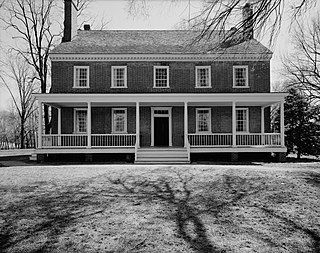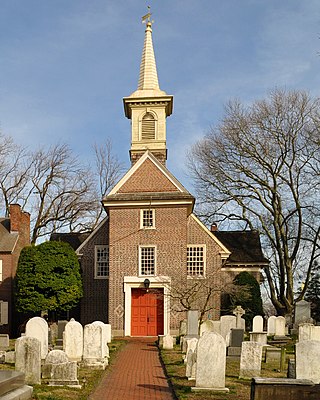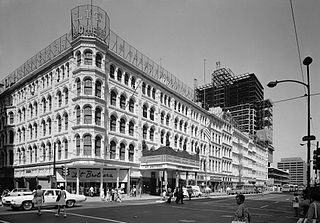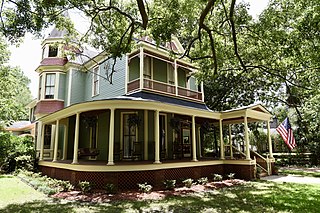
Historic Locust Grove is a 55-acre 18th-century farm site and National Historic Landmark situated in eastern Jefferson County, Kentucky in what is now Louisville. The site is owned by the Louisville Metro government, and operated as a historic interpretive site by Historic Locust Grove, Inc.

The Bellevue-Stratford Hotel is a landmark building at 200 S. Broad Street at the corner of Walnut Street in Center City Philadelphia, Pennsylvania. Constructed in 1904 and expanded to its present size in 1912, it has continued as a well-known institution for more than a century and is still widely known by that original, historic name. In 1988, the building was converted to a mixed-use development. It has been known since then as The Bellevue. The hotel portion is currently managed by Hyatt as The Bellevue Hotel.

Old City is a neighborhood in Center City, Philadelphia, Pennsylvania, United States, near the Delaware River waterfront. It is home to Independence National Historical Park, a dense section of historic landmarks including Independence Hall, the Liberty Bell, the First Bank of the United States, the Second Bank of the United States, and Carpenters' Hall. It also includes historic streets such as Elfreth's Alley, dating back to 1703.

The Driskill, a Romanesque-style building completed in 1886, is the oldest operating hotel in Austin, Texas, United States, and one of the best-known hotels in Texas generally. The Driskill was conceived and built by Col. Jesse Driskill, a cattleman who spent his fortune constructing "the finest hotel south of St. Louis".

The architecture of Philadelphia is a mix of historic and modern styles that reflect the city's history. The first European settlements appeared within the present day borders of Philadelphia, Pennsylvania in the 17th century with most structures being built from logs. By the 18th century, brick structures had become common. Georgian and later Federal style buildings dominated much of the cityscape. In the first half of the 19th century, Greek revival appeared and flourished with architects such as William Strickland, John Haviland, and Thomas U. Walter. In the second half of the 19th century, Victorian architecture became popular with the city's most notable Victorian architect being Frank Furness.

G. W. & W. D. Hewitt was a prominent architectural firm in the eastern United States at the turn of the twentieth century. It was founded in Philadelphia in 1878, by brothers George Wattson Hewitt (1841–1916) and William Dempster Hewitt (1847–1924), both members of the American Institute of Architects. The firm specialized in churches, hotels and palatial residences, especially crenelated mansions, such as Maybrook (1881), Druim Moir (1885–86) and Boldt Castle (1900–04).

The Franklin Residences is a historic apartment building located at 834 Chestnut Street in Center City, Philadelphia, Pennsylvania. It opened on January 14, 1925, as the Benjamin Franklin Hotel and was named after United States Founding Father Benjamin Franklin.

Jewelers' Row, located in the Center City section of Philadelphia, Pennsylvania, United States, is composed of more than 300 retailers, wholesalers, and craftsmen located on Sansom Street between Seventh and Eighth Streets, and on Eighth Street between Chestnut and Walnut Streets.

The Battle House Renaissance Mobile Hotel & Spa, is a historic hotel in Mobile, Alabama. The current structure was built in 1908 as the Battle House Hotel. It is the second hotel by that name to stand in this location, replacing an earlier Battle House built in 1852, which burned down in 1905. It is one of the earliest steel frame structures in Alabama.

Martin Hall, also known as the George M. Bradley House is a historic house on the upper campus of Providence College.

The Atlanta Biltmore Hotel and Biltmore Apartments is a historic building located in Atlanta, Georgia. The complex, originally consisting of a hotel and apartments, was developed by William Candler, son of Coca-Cola executive Asa Candler, with Holland Ball Judkins and John McEntee Bowman. The original hotel building was converted to an office building in 1999. The building is currently owned by the Georgia Institute of Technology and is adjacent to Technology Square.

Charles M. Autenrieth (1828–1906) was an American architect whose practice was centered in Philadelphia. From 1852 to 1902, he was in partnership with Edward Collins, and thereafter with his son, Charles M. Autenrieth, Jr.

Paradise Park Historic District is located in Thomasville, Georgia. It was listed on the National Register of Historic Places 1984 with an increase in 2002. It consists of Thomasville's Paradise Park, and properties including 15 contributing buildings and one non-contributing building.
The University of Arkansas Campus Historic District is a historic district that was listed on the National Register of Historic Places on September 23, 2009. The district covers the historic core of the University of Arkansas campus, including 25 buildings.

Francis McNeirny was an American clergyman of the Roman Catholic Church who served as Bishop of Albany from 1877 until his death in 1894.

The Hannah Maria Libby Smith House, also known as the Arnel Milner Home, is a historic house located in Provo, Utah, United States. It is listed on the National Register of Historic Places.

The Manzanita Lake Naturalist's Services Historic District encompasses the historic area devoted to visitor interpretation services at the northwest entrance of Lassen Volcanic National Park in northeastern California. The district's earliest structures were built by Benjamin and Estella Loomis, who were instrumental in the establishment of the park and among the park's first concessioners. The 1927 Loomis Museum and its seismograph hut were built by the Loomises and were donated, together with 40 acres (16 ha) of land to the National Park Service in 1929. The Loomis House, also known as the Loomis Art House and Manzanita Lake Ranger Station, was built about the same time as the museum and served as their residence, photography studio and shop until the 1950s under the name "B.F. Loomis Photo and Art Store".

Brooks House, also known as the Hotel Brooks, is an historic building located at the corner of Main Street and High Street in downtown Brattleboro, Vermont. It was built in 1871 and designed by the architectural firm of E. Boyden & Son of Worcester, Massachusetts in the provincial Second Empire style for George Brooks, to replace a previous hotel on the site which had burned down. When it was completed, the luxury hotel had 80 rooms which were lavishly furnished. It was added to the National Register of Historic Places in 1980.

Appleton Prentiss Clark Jr. was an American architect from Washington, D.C. During his 60-year career, Clark was responsible for designing hundreds of buildings in the Washington area, including homes, hotels, churches, apartments and commercial properties. He is considered one of the city's most prominent and influential architects from the late 19th and early 20th centuries. Many of his designs are now listed on the National Register of Historic Places (NRHP).

The Jenks Tavern, also known historically as the East Rupert Hotel and the Hotel G. Jenks, is a historic public accommodations house at the junction of West Dorset Road with Vermont Routes 315 and 30 in Rupert, Vermont. Built about 1807, it is a well-preserved example of an early 19th-century traveler's accommodation in southern Vermont. It was listed on the National Register of Historic Places in 1994. The building is now a private residence, the home of American playwright and author John Nassivera.























